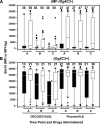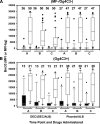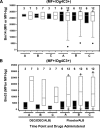Multiplex bead assay for serum samples from children in Haiti enrolled in a drug study for the treatment of lymphatic filariasis
- PMID: 21813840
- PMCID: PMC3144818
- DOI: 10.4269/ajtmh.2011.11-0029
Multiplex bead assay for serum samples from children in Haiti enrolled in a drug study for the treatment of lymphatic filariasis
Abstract
A multiplex bead assay (MBA) was used to analyze serum samples collected longitudinally from children enrolled in a drug trial for treatment of filariasis in Leogane, Haiti. Recombinant antigens Bm14 and Bm33 from Brugia malayi, third polar tube protein (PTP3) from Encephalitozoon cuniculi, and merozoite surface protein-1(19) (MSP-1(19)) from Plasmodium falciparum were coupled to carboxylated polystyrene microspheres. IgG responses to PTP3 and MSP-1(19) were not affected by albendazole (ALB), diethylcarbamazine (DEC), or combination of diethylcarbamazine and albendazole (DEC/ALB). However, IgG and IgG4 responses to Bm14 and Bm33 were significantly decreased (P < 0.001) by DEC and DEC/ALB treatment. Antibody responses to Bm14 and Bm33 decreased after DEC treatment (but not placebo) among children who were negative for microfilaremia and antigenemia at baseline, suggesting that these children harbored early stages of infection. The MBA is an excellent serologic technique for multiple antigens that offers substantial advantages over single-antigen based enzyme-linked immunosorbent assay in mass drug administration studies for monitoring changes in antibody levels.
Figures



Similar articles
-
Bancroftian filariasis: effect of repeated treatment with diethylcarbamazine and albendazole on microfilaraemia, antigenaemia and antifilarial antibodies.Trans R Soc Trop Med Hyg. 2006 Jul;100(7):656-62. doi: 10.1016/j.trstmh.2005.08.015. Epub 2006 Jan 18. Trans R Soc Trop Med Hyg. 2006. PMID: 16414095
-
Evaluation of effectiveness of diethylcarbamazine/albendazole combination in reduction of Wuchereria bancrofti infection using multiple infection parameters.Acta Trop. 2011 Sep;120 Suppl 1:S33-8. doi: 10.1016/j.actatropica.2010.09.009. Epub 2010 Oct 8. Acta Trop. 2011. PMID: 20933491 Clinical Trial.
-
Safety and efficacy of co-administered diethylcarbamazine, albendazole and ivermectin during mass drug administration for lymphatic filariasis in Haiti: Results from a two-armed, open-label, cluster-randomized, community study.PLoS Negl Trop Dis. 2020 Jun 8;14(6):e0008298. doi: 10.1371/journal.pntd.0008298. eCollection 2020 Jun. PLoS Negl Trop Dis. 2020. PMID: 32511226 Free PMC article. Clinical Trial.
-
An analysis of the safety of the single dose, two drug regimens used in programmes to eliminate lymphatic filariasis.Parasitology. 2000;121 Suppl:S147-60. doi: 10.1017/s0031182000007423. Parasitology. 2000. PMID: 11386686 Review.
-
Model-based analysis of trial data: microfilaria and worm-productivity loss after diethylcarbamazine-albendazole or ivermectin-albendazole combination therapy against Wuchereria bancrofti.Trop Med Int Health. 2006 May;11(5):718-28. doi: 10.1111/j.1365-3156.2006.01606.x. Trop Med Int Health. 2006. PMID: 16640625 Review.
Cited by
-
Rapid Point-of-Contact Tool for Mapping and Integrated Surveillance of Wuchereria bancrofti and Onchocerca volvulus Infection.Clin Vaccine Immunol. 2015 Aug;22(8):896-901. doi: 10.1128/CVI.00227-15. Epub 2015 May 27. Clin Vaccine Immunol. 2015. PMID: 26018537 Free PMC article.
-
Longitudinal monitoring of the development of antifilarial antibodies and acquisition of Wuchereria bancrofti in a highly endemic area of Haiti.PLoS Negl Trop Dis. 2012;6(12):e1941. doi: 10.1371/journal.pntd.0001941. Epub 2012 Dec 6. PLoS Negl Trop Dis. 2012. PMID: 23236534 Free PMC article.
-
Seroprevalence of antibodies against Chlamydia trachomatis and enteropathogens and distance to the nearest water source among young children in the Amhara Region of Ethiopia.PLoS Negl Trop Dis. 2020 Sep 2;14(9):e0008647. doi: 10.1371/journal.pntd.0008647. eCollection 2020 Sep. PLoS Negl Trop Dis. 2020. PMID: 32877398 Free PMC article.
-
Specificity of the IgG antibody response to Plasmodium falciparum, Plasmodium vivax, Plasmodium malariae, and Plasmodium ovale MSP119 subunit proteins in multiplexed serologic assays.Malar J. 2018 Nov 9;17(1):417. doi: 10.1186/s12936-018-2566-0. Malar J. 2018. PMID: 30413163 Free PMC article.
-
Multiplex Serology for Measurement of IgG Antibodies Against Eleven Infectious Diseases in a National Serosurvey: Haiti 2014-2015.Front Public Health. 2022 Jun 9;10:897013. doi: 10.3389/fpubh.2022.897013. eCollection 2022. Front Public Health. 2022. PMID: 35757611 Free PMC article.
References
-
- Wagner B, Freer H. Development of a bead-based multiplex assay for simultaneous quantification of cytokines in horses. Vet Immunol Immunopathol. 2009;127:242–248. - PubMed
-
- Waterboer T, Sehr P, Michael KM, Franceschi S, Nieland JD, Joos TO, Templin MF, Pawlita M. Multiplex human papillomavirus serology based on in situ-purified glutathione S-transferase fusion proteins. Clin Chem. 2005;51:1845–1853. - PubMed
Publication types
MeSH terms
Substances
LinkOut - more resources
Full Text Sources
Research Materials
Miscellaneous

